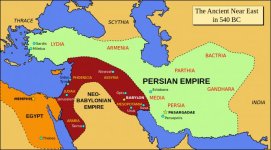They are said to be a branch of the Casluhim--an unknown people--or, according to Septuagint, of the Casmanim, which would mean "shavers of the head"
So.....the Philistine warrior Goliath was a 6ft 8 bald guy?

Follow along with the video below to see how to install our site as a web app on your home screen.

Note: This feature currently requires accessing the site using the built-in Safari browser.
They are said to be a branch of the Casluhim--an unknown people--or, according to Septuagint, of the Casmanim, which would mean "shavers of the head"

Sure!
Here's some of the studies that talk about the finds of South Italian pottery and those of Italian weapons in the Levant and the Aegean, and the link between Italy and the Eastern Mediterranean in the LBA:
http://www.academia.edu/225687/M._M...diterranean_Aegean_Archaeology_8_2008_111_136
http://www.raco.cat/index.php/CuadernosArqueologia/article/viewFile/276368/392932
https://books.google.it/books?id=F_...age&q=mont'e prama pyla kokkinokremos&f=false
http://honorfrostfoundation.org/up-...-mediterranean-linda-hulin-and-s-german-2016/
http://dspace.unive.it/handle/10579/4297
https://www.academia.edu/16412583/T...gy_and_History_in_the_Lebanon_26_2007_212-233

Interestingly, they seem to have worshiped a Middle Eastern god, although how could you prove how or why they adopted him.
http://www.bible-history.com/past/dagon.html

So.....the Philistine warrior Goliath was a 6ft 8 bald guy?

They won't reveal the DNA because it would be too controversial when they discover Philistines were Aegean and not semitic.
Even though the word "Philistine" in the dictionary means:

thanks for your links Pygmalion
Some time ago i have posted something similar on another thread of this forum but other users thought that i was writing bullshi*** eheh
http://www.eupedia.com/forum/threads/34081-The-kurgan-was-empty/page2
http://www.eupedia.com/forum/threads/34081-The-kurgan-was-empty/page3
The presence of Bronze Age Italians,Sardinians and Sicilians in the Aegean is a well know fact..

thanks for your links Pygmalion
Some time ago i have posted something similar on another thread of this forum but other users thought that i was writing bullshi*** eheh
http://www.eupedia.com/forum/threads/34081-The-kurgan-was-empty/page2
http://www.eupedia.com/forum/threads/34081-The-kurgan-was-empty/page3
The presence of Bronze Age Italians,Sardinians and Sicilians in the Aegean is a well know fact..
This thread has been viewed 23195 times.
